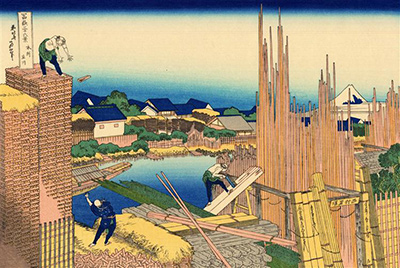One of his most intricate works perhaps, is Katsushika Hokusai's Honjo Tatekawa, the timberyard at Honjo Sumida. This Japanese woodblock print depicts a work of landscape art by Hokusai, part of his Thirty Six Views of Mount Fuji series of woodblock prints.
It portrays both industry and activity rendered in the traditional Ukiyo-e style, using transparent, water-based ink. It's very much a linear work that makes use of juxtaposing angles in every aspect to create areas of visual interest. Our eyes are immediately drawn to the long, vertical lines of timber to the the right, then over to the curiously stooped postures of the men working in the yard. Even those forms of flesh and bone are strangely angular. Upon further examination, we find the rooftops of the houses to consist of an assortment of angles, the only softening feature being the curved treetops or bushes amidst houses and timber.
The man on the upper left hand side throws what appears to be a timber log down to his waiting co-worker far below, while a third man is bent over his saw, to the right of the picture, sawing his timber in a perfectly straight line. The print captures an incredible amount of work achieved, energy spent; yet we only see three men on the scene. Its appeal stems from its illustration of activity and the suggestion of a movement toward progressiveness.
Hokusai pays further tribute to this theme through similar works within this series. Such woodblock landscapes from the Thirty-Six Views series include Fuji From the Katakura Tea Fields In Suruga and Nobofura Bay. While both feature landscapes of Japan, the predominant themes of these and other prints are, in fact the interactions of the subjects between their environment. While it is unsure whether it was the intention of the artist to portray daily life or something deeper, there can be no doubt that with Honjo Tatekawa the Timberyard At Honjo Sumida, Hokusai felt an affinity for those who strove to master their enviroment.




